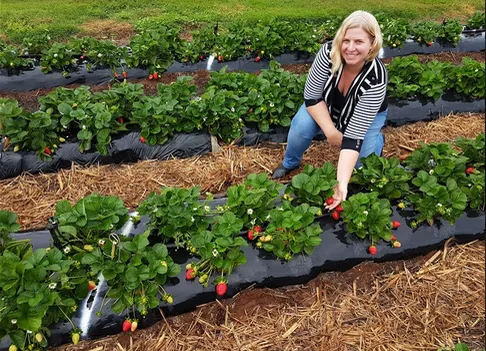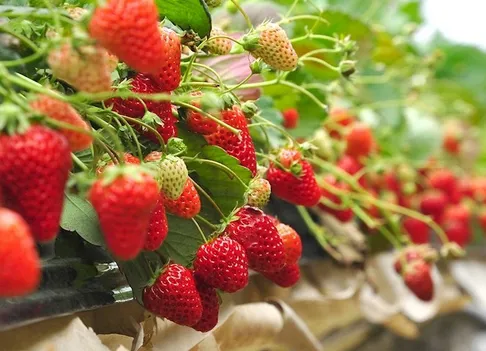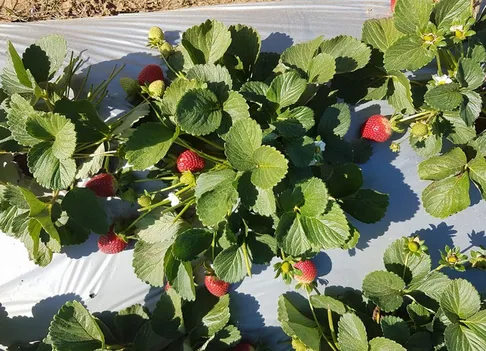Strawberry researchers are seeking a commercial partner to hold the licence for new temperate strawberry varieties, which have come from the Australian Strawberry Breeding Program (ASBP).
Hort Innovation is running an Expression of Interest process to find suitably qualified, experienced and capable growers to continue the development of the varieties that have been years in the making.
"We are looking for a temperate commercialisation partner," Queensland Department of Agriculture and Fisheries (DAF), Strawberry breeder Dr Jodi Neal said. "So, this is for all the material coming out of the (ASBP) current temperate breeding project. The temperate program incorporates Victoria, Tasmania, South Australia, southern Western Australia, ACT, and the Stanthorpe region of Queensland, so it is a very broad area."

Photo: Dr Jodi Neal with Red Rhapsody, credit: Louella Woolcock
The ASBP is a national project, funded by Hort Innovation in partnership with DAF. The program develops improved varieties that target all of the country's major production regions, which is divided into three categories; sub-tropical, temperate and Mediterranean climates. It first was launched over 20 years ago and only included Queensland, but now Dr Neal says it has gone national - and over the history of the program, the research has led to the commercialisation of numerous new varieties, including 12 in recent years.
"We haven't been breeding for temperate or Mediterranean climates for very long, and so we have only recently released some varieties for those regions," Dr Neal said. "There hasn’t been time yet get a feel for likely industry uptake in these regions, but our sub-tropical program has been very successful. Last year, 80 per cent of all strawberry plants grown in Queensland were our varieties - and it's even higher this year. Our biggest seller has been 'Red Rhapsody'. Overall, it has been a fantastic uptake from the industry; most sub-tropical growers have it, and some are growing just Red Rhapsody."

Photo courtesy: Hort Innovation
Queensland is Australia’s largest strawberry producer with an average industry value of $171 million over the past five years, with the breeding program credited with a large part of this success. Dr Neal added that new varieties have to take into consideration improvements at both an agronomic and a consumer level.
"The product needs to stand out to consumers in the store; meaning it looks so good they put it in their trolley then tastes so good they keep going back to buy some more," she said. "In addition to that, there can be no fruit available for consumers unless it is profitable for the growers to grow. We have to balance consumer traits with things that increase the profitability and cost-effectiveness of strawberry growing. With strawberries, it is all manual labour, meaning it is picked and packed by hand. So, anything that we can build into a variety that can shave seconds off the picking time of each fruit and time to fill a punnet makes a difference, for example, large fruit size, good bruise resistance etc."

Photo: Red Rhapsody plant, credit: Dr Jodi Neal
Dr Neal says some of the characteristics of the new varieties include white and pale coloured strawberries, which are a creamy colour and have a rosy blush, like a peach, and are very sweet with a hint of pineapple in their flavour.
"We also screen our breeding material for the presence of a gene for peach flavour - it's a single volatile aromatic that contributes a slight peach-like flavour to strawberries," Dr Neal said. "It's just one of many things that contribute to making a strawberry taste like a strawberry, and the presence of this volatile can contribute to a better taste."
The process generally takes five years for a variety to progress through the breeding pipeline and be available for commercialisation when IP protection is placed on it and it is made available to the nurseries to start bulking up. The program is in collaboration with Australian strawberry growers, and Dr Neal says the grower involvement is invaluable in producing the best tasting and yielding varieties.

Photo: Panoramic view of temperate trial, credit: Dr Jodi Neal
"We could not do this without the industry," she said. "They are absolutely vital to our project and we try to keep them involved as possible, because we need to know from them what they are looking for in new varieties and if there are changes in the market or in the production system. I contact growers all-year round and we have regional reference groups with industry representatives that get together at least once a year, to review results and share their opinions on how we are doing things. We put our advanced material on a small number of grower’s farms across the country for two years before we commercialise, so we can get feedback on which accessions have commercial potential."
The expression of interest is available on the Hort Innovation website and closes on September 14.
For more information click here
Queensland Department of Agriculture and Fisheries
Phone: +61 7 5381 1300
info@daf.qld.gov.au
